Lately I’ve been having a lot of conversations around investment terms with searchers, as well as investors.
About 15 years ago, I interned at a search fund. And, over the last few years, I’ve started to invest in the asset class going direct as well as through funds of search funds.
Investing in search funds is a great way to scratch my entrepreneurial itch, extremely rewarding when a searcher finds success, and can be economically rewarding too.
This post is my attempt to share thoughts on self funded search economics in an effort to contribute to the search fund community, get feedback on my thinking from a wider audience, and of course meet more people who are doing searches/investing and may want to collaborate (please feel free to reach out!).
You can watch a video of me explaining this model here, and download the excel here:

Enterprise Value
The standard finance equation is enterprise value = debt + stock – cash. Enterprise value is how much the company itself is worth. Many times people confuse it with how much the stock is worth and find the “minus cash” part of this really confusing.
So, you can rearrange this equation to make it stock = enterprise value – debt + cash. Make more sense now?
Enterprise value is just how much you’re willing to pay for the company (future cash flows, intellectual property, etc), not the balance sheet (debt and cash).
Most investors and searchers think about the EBITDA multiple of a company on an enterprise value basis because they’ll be buying it on a cash free, debt free basis. It becomes second nature to think about EBITDA multiples and know where a given business should fall given scale, industry, etc.
However, I believe this second nature way of thinking of things can be a massive disadvantage to investors given the way EV and multiples are talked about in our community currently.
Sources of capital, the typical way to calculate enterprise value for self funded searchers
If you’ve ever looked at or put together a teaser for a self funded search deal, you will notice that the deal value is equal to the sum of the sources of capital minus deal fees and cash to the balance sheet.
As a simple example, if there is $4 mm of debt to fund the deal, $1 mm of equity, and $200k of deal fees, the enterprise value = $4 mm + $1 mm – 200k = $4.8 mm.
We’ll use slightly more complex numbers in our example: If a searcher is taking a $3.2 mm SBA loan, $850k seller note, putting in $120k themselves, getting $350k of equity from the seller, a $500k earnout, and $1.2 mm of equity financing minus $350k to the balance sheet and $250k of deal fees, then the enterprise value will be $5.62 mm.
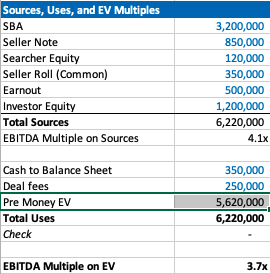
Our example company has $1.5 mm of EBITDA, so the EBITDA multiple is 3.7x. This is a pretty attractive acquisition multiple for a business that meets traditional search criteria (recurring revenues, fragmented competition, high gross margins, low customer concentration, etc).
If you’re seeing a search fund deal for the first time, the headline of “we’re buying a decent company for 3.7x, and replacing a tired owner with a hungry operator” is pretty exciting!
However, if you’re an investor, there is some nuance to this enterprise value number and the true EBITDA multiple you are investing in.
The trick with self funded enterprise value
The security that most self funded search investors get in a deal is participating preferred stock with a paid in kind dividend. This means when there’s an exit, you get your money back before any other equity holder, then get a certain percent of the business, and whatever dividend you’ve been owed in the interim accrues to your principle.
It’s a really favorable security for the investor, and one that is basically impossible to get in VC where straight preferred stock is much more common (no pun intended).
The key terms are what percent of common equity does this security convert into after the originally principal is paid back, and what is the dividend.
The share of common equity the investor group will get typically ranges from 10-50% of the total common stock. The dividend rate is usually 3-15%. The average I’m seeing now is around 30% and 10% for common and dividends respectively.
The strange this about the enterprise value quoted to investors in a teaser/CIM is that it doesn’t change as the percent of common changes, even though this has large implications for how much the common equity is worth and the value investors receive.
For example, I may get a teaser where the sources of investment – cash to balance sheet – deal fees = $3.7 mm for a $1 mm EBITDA company, which would imply a 3.7X EBITDA multiple. Let’s say the searcher is offering investors 30% of the common and a 10% dividend.
Let’s now say that the searcher is having a tough time raising capital and changes their terms to 35% of common and a 12% dividend. Does the effective enterprise value change for investors? I would argue yes, but I would be surprised to see it changed in the CIM/teaser.
This isn’t a knock on searchers or the search fund community. It’s just kind of how things are done, and I think this is mostly because it’s really hard to think about how the enterprise value has changed in this scenario.
However, the natural way of using EBITDA multiples to think about value for a business that is so common in PE/SMB can be extremely misleading for investors here. You may be thinking 3.7X for this type of business is a great deal! But, what if the security you’re buying gets 5% of the common?
If you’re in our world, you may counter this point by saying most searchers will also supply a projected IRR for investors in their CIM. However, IRR is extremely sensitive to growth rate, margin expansion, and terminal value. While the attractiveness of the security will be reflected, it can be greatly overshadowed by lofty expectations.
To get more clarity and have a slightly different mental model on the effective price investors are paying for this business, let’s go back to basics. Enterprise value should be debt + preferred stock + common stock – cash.
We know the values of each of these numbers, except the common. So, the main question here becomes: how much is the common equity worth?
Calculating value of common equity for self funded search funds
Equity value for most search fund deals = preferred equity from investors + the common equity set aside for the searcher and sometimes also advisors, board, seller.
We know that the preferred equity is investing a certain amount for a certain amount of common equity. The rub is that they are also getting a preference that they can take out before any common equity gets proceeds, and they are getting a dividend.
So, the exercise of valuing the common equity comes down to valuing the preference and dividend.
In my mind, there are three approaches:
- The discount rate method where you take the cash flows you’ll get in the future from the pref/dividends and discount them back at the discount rate of your choice. I am using 30% in my model which I believe accurately compensates investors for the risks they are taking in a small, highly leveraged investment run by an unproven operator. If you believe in efficient markets, this number also fits as it mirrors the historical equity returns as reported by the Stanford report, with a slight discount given this asset class has clearly generated excess returns relative to other assets on a risk adjusted basis, hence interest in these opportunities from an expanding universe of investors.
- The second method is to calculate how much money you’d get from your preference and dividends, taking into account that per the Stanford study around 75% of search funds will be able to pay these sums, and then discount these cash flows back at a rate more in line with public equities (7% in my model). This yields a much higher value to the preference/dividend combo, and therefore lowers the implied value of the common equity.
- The last method is to just say nope, there is no value to the preference and dividend. I need them and require them as an investor, but they are a deal breaker for me if they aren’t there, and therefore they don’t exist in my math. This of course makes no logical sense (you need them, but they also have no value?), but I’ve left it in as I think many investors probably actually think this way and it creates a nice upper bound on the enterprise value. Side note, as with obstinate sellers, jerk investors are usually best avoided.
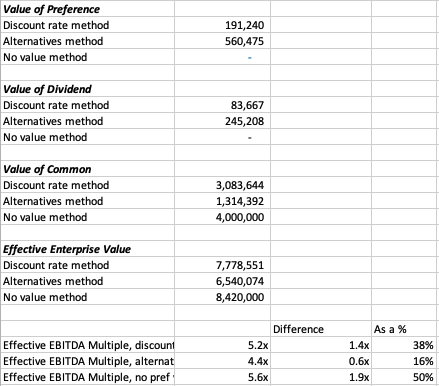
In our example, you can see a breakdown of the preference value, dividend value, and therefore common value and enterprise value for this deal.
In each case, the effective EBITDA multiple moves from 3.7x to something much higher (see the last 3 lines).
There are some simplifying assumptions in the model (no accruing dividend, all paid in last year), and some weird stuff that can happen (if you make the hold time long and the dividend greater than the 7% equity discount rate, the value of the dividend can get really big).
These flaws aside, I think this creates a nice framework to think through what the common is actually worth at close, and therefore what enterprise value investors will be paying in actuality.
It’s worth noting that the whole point of this is to benchmark the value you’re getting relative to market transactions in order to understand where you want to deploy your capital.
This creates a method to translate cash flow or EBITDA multiples of other opportunities on an apples to apples basis (if only there were a magical way to translate the risk associated with each as well!).
Another note, we could calculate the value of the common to be what this asset would trade at market today in a well run auction process minus any obligations (debt, preference, seller financing). However, I think that understates the option value inherent in this equity, a value that is only realized when a new manager takes over with more energy and know how.
There is a finance nerd rational for this. If you plot the value of equity in a leveraged company on a chart, it mirrors the payout of a call option. In both cases, the value of the security increases at a certain inflection point: when the value of equity rises above the strike price in an option, and when the enterprise value of a company rises above the debt level in a levered company.
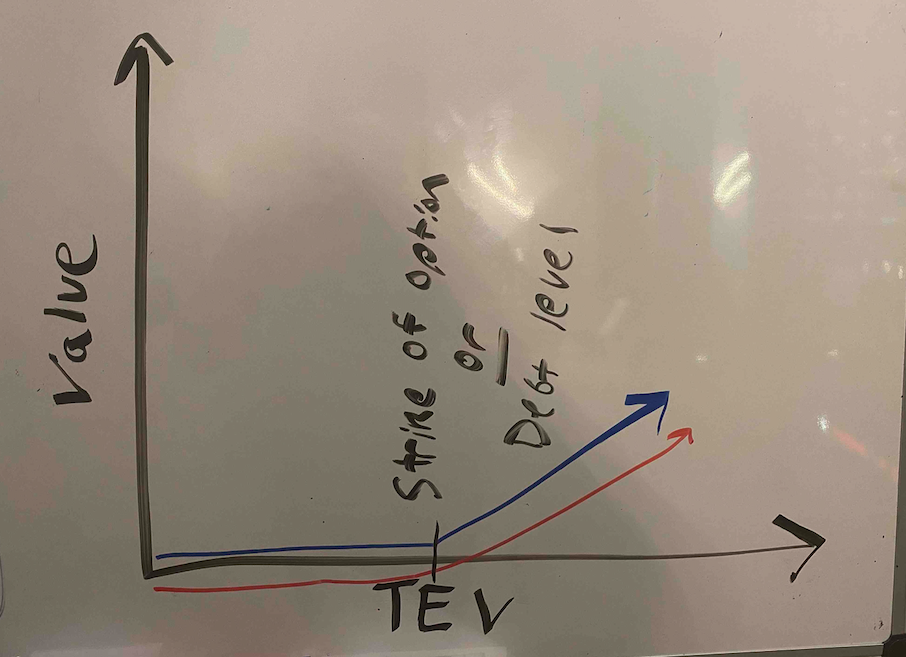
The common equity of a highly levered company can therefore be valued by a similar methodology as the call option: Black Scholes. If you remember back to finance class, increasing volatility will increase the value of an option.
In the search fund case, we’ve (hopefully) increased the (upside) volatility and therefore create more value than simply selling the company today.
A few more thoughts on investor economics
There are a few other ways to think about the economics you get as an investor to best understand if this is the deal for you.
First, you may want to think about how much your investment will be worth day 1. The key lever in this model is what discount this company is being bought for relative to fair market value. For example, the searcher may have proprietary sourced a great company and is buying it for 25% below what it would trade at in a brokered auction.
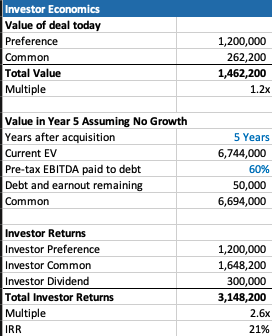
This is very much a “margin of safety” philosophy on things. Same with the calculation on how much you’ll receive in year 5 (after QSBS hits) assuming no growth in the business.
The only problem with each of these calculations is that they never play out in practice. Most companies don’t just stay the same, you’re either in a rising tide or you’re in trouble. And, you’re almost never going to sell in year 1, and definitely not for a slight premium to what it was bought for.
However, if your investment is worth 30% higher day one, and you can make a 20% IRR assuming nothing too crazy happens either way in the business, that’s not a bad place to start. Add in a strong searcher, decent market, some luck, and you’re off to the races.
Thoughts on searcher economics
A lot of this post has considered things from the investor perspective as my main quandary was related to how to create an EBITDA multiple that made sense for investors.
However, the point of this post is not to say searchers are misrepresenting or being unrealistic with their terms. In fact, I think it’s quite logical that self funded searchers capture the massive economic value that they do.
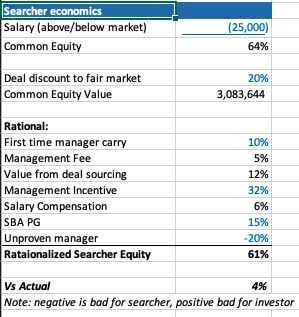
There are many reasons why self funded searchers deserve the lion share of the common equity.
First, they are providing a nice service of giving investors a positive expected value home to park their money with much lower correlation to the market than other asset classes ($1 mm EBITDA companies don’t see lots of multiple contraction/expansion throughout cycles).
Most money managers that fit that criteria are taking a 2/20, of course they also usually have a track record. So, I’ve used a 10% carry in my model, but stuck to 2% annual management fee.
The searcher spent a lot of time, and probably money, finding this company. That’s a lot of value, especially if it’s a below market price. They should be able to capture a lot of the value in finding a below market deal.
The searcher may be taking a below market salary, and needs to get comped like any CEO, with stock options. In my example model I have $1 mm of stock vesting over the hold period, as well as extra comp for taking a below market salary.
Searchers are also usually putting their financial standing at risk by taking a personal guarantee on the bank/SBA loan. This is really tough to put a number on, as is the last line in my framework where searchers are dinged for lack of experience. Like any good model, you need a few lines that you can fudge to make the math work 🙂
What you do think?
I’m shocked that I wrote all this. I was going to type a few paragraphs and a quick excel. However, putting this to paper has been a great exercise for me to sharpen my thinking.
Now I’d like you to help me further. Where do you think this should be changed in this framework? How do you think about things from the investor and/or searcher side?
Feel free to shoot me a note if you have thoughts (even just to tell me I’m being way too academic with this, which I actually agree with).
Lastly, a post like this is really a trap I’m putting on the internet to catch any like minded people in so that we can figure out ways to collaborate now or in the future. So, at the very least, connect with me on LinkedIn 🙂

Hi it’s me, I am also visiting this web site daily, this web site is actually nice and the users
are truly sharing fastidious thoughts.
Great article! This is the type of information that are supposed to
be shared across the net. Shame on Google for no longer positioning this publish upper!
Come on over and talk over with my web site . Thanks =)
Hey there! Someone in my Myspace group shared this website with us
so I came to take a look. I’m definitely loving the information. I’m book-marking and will be tweeting this to
my followers! Fantastic blog and amazing design and style.
I do accept as true with all the ideas you’ve introduced in your post.
They’re very convincing and will certainly work.
Still, the posts are very quick for novices. May you please
prolong them a little from next time? Thank you for the
post.
I’m gone to say to my little brother, that he should also go to see this webpage
on regular basis to get updated from newest news.
I was curious if you ever considered changing the layout
of your site? Its very well written; I love what youve got to say.
But maybe you could a little more in the way of content so people could connect with it better.
Youve got an awful lot of text for only having 1
or 2 pictures. Maybe you could space it out better?
Thanks for sharing your thoughts on situs sabung ayam.
Regards
Thanks to my father who told me about this webpage, this website is in fact amazing.
Hi there would you mind stating which blog platform you’re using?
I’m looking to start my own blog in the near future but I’m having a difficult time selecting between BlogEngine/Wordpress/B2evolution and
Drupal. The reason I ask is because your design and style seems different then most blogs and I’m looking for something unique.
P.S My apologies for being off-topic but I had to ask!
I was suggested this web site by means of my cousin. I am
now not certain whether this publish is written by him as nobody else recognize such certain approximately my problem.
You’re wonderful! Thanks!
This design is incredible! You definitely know how to keep a reader
amused. Between your wit and your videos, I
was almost moved to start my own blog (well, almost…HaHa!) Great
job. I really enjoyed what you had to say, and more than that,
how you presented it. Too cool!
I am genuinely happy to read this web site posts which carries plenty of helpful data, thanks for providing these kinds of data.
Hi! I’ve been reading your website for a while
now and finally got the bravery to go ahead and give you a shout out
from Lubbock Texas! Just wanted to mention keep up the great job!
I was curious if you ever considered changing the layout
of your website? Its very well written; I love what youve
got to say. But maybe you could a little more in the way of content so people could connect with it better.
Youve got an awful lot of text for only having one
or two pictures. Maybe you could space it out better?
Thanks for another informative website. Where
else could I get that type of info written in such an ideal approach?
I’ve a mission that I am simply now operating on, and I’ve been on the
look out for such info.
My brother suggested I would possibly like this blog.
He was totally right. This post actually made my day.
You can not consider simply how much time I
had spent for this information! Thanks!
Hi, just wanted to mention, I loved this article. It was funny.
Keep on posting!
Thank you, I’ve just been searching for info approximately this subject for ages and yours is the best
I have discovered till now. But, what about the conclusion?
Are you positive about the source?
Hey there! I just want to give you a huge thumbs up for the excellent information you have right here on this post.
I am returning to your web site for more soon.
Excellent pieces. Keep posting such kind of info on your blog.
Im really impressed by your blog.
Hi there, You’ve performed an excellent job. I’ll definitely digg it and for my part
recommend to my friends. I am sure they will be benefited from this web site.
Fabulous, what a web site it is! This webpage gives helpful data to us, keep it up.
Awesome website you have here but I was curious about if
you knew of any community forums that cover the same
topics talked about in this article? I’d really love to be a
part of group where I can get feed-back from other knowledgeable individuals that share
the same interest. If you have any recommendations, please let me know.
Kudos!
Thank you for the auspicious writeup. It in fact was a amusement account it.
Look advanced to more added agreeable from you!
However, how can we communicate?
Hello there! Do you use Twitter? I’d like to follow you if that
would be ok. I’m definitely enjoying your blog and look forward to new posts.
Every weekend i used to visit this site, because i want enjoyment, since this this web page conations really nice funny information too.
Generally I do not learn article on blogs, however
I would like to say that this write-up very pressured me to try and
do it! Your writing style has been amazed me.
Thank you, very nice article.
Greetings! Very helpful advice within this post!
It’s the little changes that produce the most significant changes.
Thanks a lot for sharing!
Admiring the time and effort you put into your website and detailed information you provide.
It’s nice to come across a blog every once in a while that isn’t the same out of date rehashed information.
Great read! I’ve bookmarked your site and I’m including your RSS feeds to my Google account.
It’s really a great and useful piece of info. I’m glad that you simply
shared this useful info with us. Please keep us informed like this.
Thanks for sharing.
I think the admin of this web page is in fact
working hard in favor of his website, as here every stuff is quality based
information.
of course like your website however you have to test the spelling on quite a few of your posts.
Several of them are rife with spelling problems and I to find it very troublesome to inform the truth nevertheless I will definitely come back again.
I have read so many posts concerning the blogger lovers except this piece of
writing is genuinely a fastidious piece of writing, keep it up.
I’d like to thank you for the efforts you’ve put in penning this site.
I’m hoping to check out the same high-grade content from you later on as well.
In truth, your creative writing abilities has encouraged me to get my very own site now 😉
Awesome blog! Do you have any hints for aspiring writers?
I’m planning to start my own site soon but I’m a
little lost on everything. Would you suggest starting with a free platform like WordPress or go for a paid option?
There are so many choices out there that I’m completely overwhelmed ..
Any tips? Cheers!
whoah this weblog is magnificent i love reading your articles.
Keep up the great work! You know, many individuals are searching round for this info, you can help them greatly.
Hey there! Would you mind if I share your blog with my twitter group?
There’s a lot of people that I think would really
enjoy your content. Please let me know. Thank you
An impressive share! I have just forwarded this onto a friend who had been conducting
a little homework on this. And he in fact
bought me breakfast due to the fact that I
stumbled upon it for him… lol. So allow me to reword this….
Thank YOU for the meal!! But yeah, thanks for spending
the time to talk about this topic here on your website.
I’d like to find out more? I’d want to find out
some additional information.
Oh my goodness! Impressive article dude!
Many thanks, However I am experiencing troubles with your RSS.
I don’t understand why I am unable to join it. Is there anybody else getting the same RSS issues?
Anyone who knows the solution will you kindly respond? Thanx!!
I think the admin of this website is actually working hard in favor of his web page,
as here every information is quality based
material.
Hey would you mind sharing which blog platform you’re using?
I’m planning to start my own blog soon but I’m having a hard time choosing
between BlogEngine/Wordpress/B2evolution and Drupal.
The reason I ask is because your layout seems different then most blogs and I’m looking for something completely unique.
P.S Apologies for getting off-topic but I had to ask!
Hey there would you mind stating which blog platform you’re working with?
I’m going to start my own blog in the near future but I’m having a tough time
choosing between BlogEngine/Wordpress/B2evolution and Drupal.
The reason I ask is because your layout seems different then most blogs and I’m looking for something
unique. P.S My apologies for being off-topic but I had to ask!
Hello, this weekend is good for me, as this time i am reading this great educational paragraph here at my
residence.
It’s going to be finish of mine day, however before end I am reading this fantastic article to increase
my experience.
Very good website you have here but I was curious if you knew of any forums that cover the same topics discussed here?
I’d really love to be a part of community where I can get suggestions from other experienced individuals that share the same interest.
If you have any recommendations, please let me know.
Cheers!
Right here is the right website for everyone who wants to find out about this topic.
You know so much its almost tough to argue with you (not that I actually will need to…HaHa).
You definitely put a brand new spin on a subject that has been discussed for ages.
Excellent stuff, just great!
This is the right site for anybody who hopes to find out about this topic.
You realize so much its almost tough to argue with you
(not that I really will need to…HaHa). You certainly put
a brand new spin on a topic which has been written about for years.
Excellent stuff, just great!
Somebody necessarily assist to make severely posts I might
state. That is the very first time I frequented your
web page and so far? I amazed with the research you made to
make this actual post extraordinary. Magnificent process!
What’s up to every body, it’s my first pay a quick visit of this web site;
this blog contains remarkable and in fact good stuff designed for visitors.
Thanks for any other fantastic article.
The place else may just anybody get that type of information in such an ideal method
of writing? I have a presentation subsequent week, and I’m at the
look for such information.